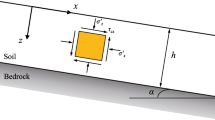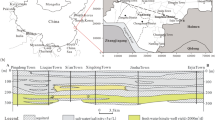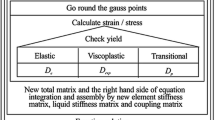Abstract
An investigation is made of the influence of fire-caused deforestation on precipitation-triggered, shallow landslide susceptibilities in southern California, using a scalable and extensible geo-fluid model (SEGMENT), that accounts for soil mechanics, root distribution, and relevant hydrologic processes. SEGMENT is applicable to variable regional topography, soil thickness profiles, and vegetation coverage. In this study, for southern California following the 2007 wildfires, three experiments were performed with rainfall recurrence periods chosen to be 2, 10, and 25 years. These intervals correspond to 24-h storm rainfall totals of 17, 25.4, and 33 mm. The model generated landslide stability maps that identified three areas of high instability. These unstable regions are located in the San Fernando Valley, the San Gabriel Mountains, and the Santa Monica Mountains. In each case, the vegetation cover had been severely burned during the preceding 2007 wildfires. The model results showed that burning from wildfires is a major destabilizing factor for southern California. Burn sites are more prone to landslides than vegetated slopes because the soil more readily exceeds its critical moisture content. Severe droughts in a future warming climate are expected to increase the likelihood of more frequent and intense wild fires. Higher temperatures combined with decreased total rainfalls facilitate more intense landslides, including devastating mudslides, following heavy precipitation. Finally, the model is designed to assist in developing timely mitigation measures for post-fire, storm-triggered landslides.





Similar content being viewed by others
References
Brooks R, Corey W (1964) Hydraulic properties of porous media. Hydrology Paper 3, Colorado State University, Fort Collins
Caine N (1980) The rainfall intensity duration control of shallow landslides and debris flows. Geogr Ann Ser A 62:2327
Campbell R (1975) Soil slips, debris flows and rainstorms in the Santa Monica Mountains and vicinity, southern California. United States Geological Society Professional Paper 851
Cannon S, Gartner J (2005) Wildfire related debris flow from a hazards perspective, Chapter 15. In: Jacob M, Hungr O (eds). Debris-flow hazards and related phenomena: Springer-Praxis Books in Geophysical Sciences, 321–344
Cannon S, Michael J, Gartner J, Gleason J (2003) Assessment of potential debris-flow peak discharges from basins burned by the 2002 Missionary Ridge Fire, Colorado, open-File Report 03-332, US Geol Surv, Denver, CO
Cannon S, Gartner J, Rupert M, Michael J (2004) Emergency assessment of debris-flow hazards from basins burned by the Cedar and Paradise Fires of 2003, southern California, Open-File Report 2004-1011, US Geol Surv, Denver, CO
Carrara A, Cardinali M, Detti R, Guzzetti F, Pasqui V, Reichenbach P (1991) GIS techniques and statistical models in evaluating landslide hazard. Earth Surf Process Landforms 16:427–445
Carter W, Shrestha R, Slatton K (2007) Geodetic laser scanning. Phys Today 60:41–47
Casadei M, Dietrich W, Miller N (2003) Testing a model for predicting the timing and location of shallow landslide initiation in soil-mantled landscapes. Earth Surf Process Landforms 28:925950
Chambers J, Higuchi N, Teixeira L, Santos J, Laurance S, Trumbore S (2004) Response of tree biomass and wood litter to disturbance in a Central Amazon forest. Oecologia 141:596–614
Chung C, Fabbri A, van Westen C (1995) Multivariate regression analysis for landslide hazard zonation. In: Carrara A, Guzzetti F (eds) Geographical information system in assessing natural hazards. Kluwer, New York, pp 107–134
Collins W, Bitz C, Blackmon M, Bonan G, Bretherton C, Carton J, Chang P, Doney S, Hack J, Henderson T, Kiehl J, Large W, McKenna D, Santer B, Smith R (2005) The community climate system model: CCSM3. Special Issue of Journal of Climate
Costa JE (1984) Physical geography of debris flows. In: Costa JE, Fleisher PJ (eds) Developments and applications in geomorphology. Springer, Berlin, pp 268–317
Crozier M, Preston N (1999) Modelling changes in terrain resistance as a component of landform evolution in unstable hill country. In: Hergarten S, Neugebauer H (eds). Process modelling and landform evolution. Lecture notes in earth science, 78, 267284. Springer, Heidelberg
Cruden DM, Varnes DJ (1996) Landslides types and processes. In: Landslides investigation and control. Special report 247. Transportation Research Board, Washington, 36–75
DeBano LF (2000) The role of fire and soil heating on water repellency in wild land environments: a review. J Hydrology 231–232:194–206
Dietrich W, Dunne T (1978) Sediment budget for a small catchment in mountainous terrain. Zeitschmft für Geomorphologie, Supplementband 29:191206
Dietrich W, Reiss R, Hsu M, Montgomery D (1995) A process-based model for colluvial soil depth and shallow landsliding using digital elevation data. Hydrol Process 9:383400
Dietrich W, Bellugi D, Real De Asua R (2001) Validation of the shallow landslide model, SHALSTAB, for forest management. In: Wigmosta M, Burges S (eds). Land use and watersheds: human Influence on hydrology and geomorphology in urban and forest areas. Water science and application, 2, 195227, American Geophysical Union
Eagleson P (1978) Climate, soil and vegetation 3. A simplified model of soil moisture movement in liquid phase. Water Resour Res 14:722–730
Godt J, Baum R, Chleborad A (2006) Rainfall characteristics for shallow land-sliding in seattle, Washington, USA. Earth Surf Process Landforms 31:97–110
Gritzner M, Marcus W, Aspinall R, Custer S (2001) Assessing landslide potential using GIS, soil wetness modeling and topographic attributes, Payette River, Idaho. Geomorphology 37:149–165
Groisman P, Knight R, Karl T, Easterling D, Sun B, Lawrimore J (2004) Contemporary changes of the hydrological cycle over the contiguous United States: trends derived from in situ observations. J Hydrometeorology 5:64–85
Homer C, Huang C, Yang L, Wylie B, Coan M (2004) Development of a 2001 national landcover database for the United States. Photogramm Eng Remote Sensing 70:829–840
Hong Y, Adler RF (2008) Predicting landslide spatiotemporal distribution: integrating landslide susceptibility zoning techniques and real-time satellite rainfall. Special Issue Int J Sediment Res 23(3):249–257
Hong Y, Adler R, Huffman G (2006) Evaluation of the potential of NASA multi-satellite precipitation analysis in global landslide hazard assessment. Geophys Res Lett 33:L22402. doi:10.1029/2006GL028010
Hong Y, Adler R, Huffman G (2007) An experimental global prediction system for rainfall-triggered landslides using satellite remote sensing and geospatial datasets, IEEE Trans Geosci Remote Sens 45(6). doi:10.1109/TGRS.2006.888436
Huffman E, MacDonald L, Stednick J (2001) Strength and persistence of fire-induced soil hydrophobicity under ponderosa and lodgepole pine, Colorado Front Range. Hydrol Process 15:2877–2892
Hungr O, Evans SG, Bovis MJ, Hutchinson JN (2001) A review of the classification of landslides of the flow type. Environ Eng Geosci 7(3):221–238
Hutchinson JN (1988) Morphological and geotechnical parameters of landslides in relation to geology and hydrogeology. In: Proceedings of the 5th international symposium on landslides, Lausanne, vol. 1, Balkema, Rotterdam, pp 3–35
IPCC (2007) Climate change 2007: The physical science basis. Contribution of Working Group I to the Fourth Assessment Report of the Intergovernmental Panel on Climate Change. Solomon, S, Qin D, Manning M (eds)
Iverson R (1997) The physics of debris flows. Rev Geophys 35:245296
Iverson R (2000) Landslide triggering by rain infiltration. Water Resour Res 36:18971910
Jibson R, Harp E, Michael J (1998) A method for producing digital probabilistic seismic landslide hazard maps: an example from the Los Angeles, California area, Open File Rep. 98–113, US Geol Surv, Denver, CO
Karl T, Trenberth K (2003) Modern global climate change. Science 302:1719–1723
Karoly D, Stott P (2006) Anthropogenic warming of central England temperature. Atmos Sci Let 7:81–85
Kharin V, Zwiers F (2005) Estimating extremes in transient climate change simulations. J Climate 18:1156–1173
Kraebel C (1934) The La Crescenta flood. American Forests 40, 251254, 286–287
Larsen M, Simon A (1993) A rainfall intensityduration threshold for landslides in a humid-tropical environment. Geogr Ann Ser A 75:1323
Lawrence D, Slater A (2008) Incorporating organic soil into a global climate model. Clim Dyn 30:145–160
Letts MG, Roulet N, Comer N, Skarupa M, Verseghy D (2000) Parametrization of Pearland hydraulic properties for the Canadian land surface scheme. Atmos Ocean 38:141–160
Liu B, Nearing M, Shi P, Jia Z (2001) Slope length effects on soil loss for steep slopes. pp 784-788. In: Sustaining the global farm. Stott D, Mohtar R, and Steinhardt G (eds)
Meyer G, Pierce J (2003) Climatic controls on fire-induced sediment pulses in Yellowstone National Park and Central Idaho: a long-term perspective. For Ecol Manage178:89–104
Moody JA, Martin DA (2001) Hydrologic and sedimentologic response of two burned watersheds in Colorado. USGS Water Resources Investigations Report
Nakicenovic N, Swart R (eds) (2000) Special report on emissions scenarios (SRES). Cambridge University Press, Cambridge and New York, p 612
NRC (2002) Abrupt climate change: inevitable surprise. National Academy Press, Washington
Potter C, Randerson J, Field C, Matson P, Vitousek P, Mooney H, Klooster S (1993) Terrestrial ecosystem production: a process model based on global satellite and surface data. Global Biogeochem Cycles 7:811–841
Ren D (2001) Scaling issues in the calculation of surface latent and sensible heat fluxes at Blue River Basin using SHEELS model. MS Thesis. University of Oklahoma, Norman, Oklahoma, 236 pp
Ren D, Xue M (2004) An improved force-restore model for land-surface modeling. J Appl Meteorol 43:1768–1782
Ren D, Leslie L, Karoly D (2007) Sensitivity of an ecological model to soil moisture simulations from two different hydrological models. Meteorology Atmos Physics 100:87–99
Ren D, Leslie L, Karoly D (2008) Mudslide risk analysis using a new constitutive relationship for granular flow. Earth Interac 12:1–16
Ren D et al (2009) Mudslide caused ecosystem degradation induced by the 2008 Wenchuan Earthquake. Geophys Res Lett. doi:10.1029/2008GL036702
Ren D, Leslie LM, Fu R, Dickinson RE, Xiang X (2010) A storm-triggered landslide monitoring and prediction system: formulation and case study. Earth Interact, (Accepted)
Reneau S, Dietrich W (1987) The importance of hollows in debris flow studies; examples from Marin County, California. Geol Soc Am Rev Eng Geol 7:165180
Richards LA (1931) Capillary conduction of liquids through porous mediums. Physics 1:318–333
Semenov V, Bengtsson L (2002) Secular trends in daily precipitation characteristics: greenhouse gas simulation with a coupled AOGCM. Clim Dyn 19:123–140
Sidle RC (1992) A theoretical model of the effects of timber harvesting on slope stability. Water Resour Res 28:18971910
Smith R, Smettem K, Broadbridge P, Woolhiser D (2002) Infiltration theory for hydrologic applications. Water resources monograph, 15, American Geophysical Union, Washington, DC
van Asch T, Malet J, van Beek L, Amitrano D (2007) Techniques, issues and advances in numerical modelling of landslide hazard. Bull Soc Geol Fr 178(2):65–88
Wagner R, Nelson R (1961) Soil survey of the San Mateo Area, California. USDA, Soil Conservation Service, series 1954, No. 13. USDA, Soil Conservation Service
Wells W (1981) Some effects of brushfires on erosion processes in coastal southern California. In: Davies T, Pearce A (eds). Erosion and sediment transport in Pacific Rim Steeplands, 305342. International Association of Hydrological Sciences. Washington, DC
Wilford D, Sakals M, Innes J, Sidle R (2005) Fans with forests: contemporary hydrogeomorphic processes on fans with forests in west central British Columbia, Canada, vol 251. Geological Society, London, pp 25–40 Special Publications
Wilson, R. (2000), Climatic variations in rainfall thresholds for debris-flow activity. In: Proceedings of first Plinius conference on mediterranean storms, 415442. Mareta, Italy, 1416 October 1999, Claps P, Wieczorek GW (eds). European Geophysical Union
Works Bureau (1998) Information paper on slope safety, Provisional Legco panel on planning, lands and works. Hong Kong Legislative Council. Available on line
Zhang X, Kondragunta S (2006) Estimating forest biomass in the USA using generalized allometric models and MODIS land products. Geophys Res Lett 33:L09402
Zhu J, Dabney S, Flanagan D (2001) Updating slope topography during erosion simulations with the water erosion prediction project. In: Stott D, Mohtar R, Steinhardt G (eds). Sustaining the Global Farm 882–887
Acknowledgments
This study was supported by start-up funds provided to the second author by the Jackson School of Geosciences, University of Texas at Austin. Trans-disciplinary studies are a team effort and we thank the USGS Wyoming Center for providing land cover and digital elevation data. We also thank Dr. Terri S. Hogue for discussions on fire burn severity classifications and hydrophobic layer formation. Drs. Dan Ren and Jiahu Wang provided GIS technical support.
Author information
Authors and Affiliations
Corresponding author
Rights and permissions
About this article
Cite this article
Ren, D., Fu, R., Leslie, L.M. et al. Modeling the mudslide aftermath of the 2007 Southern California Wildfires. Nat Hazards 57, 327–343 (2011). https://doi.org/10.1007/s11069-010-9615-5
Received:
Accepted:
Published:
Issue Date:
DOI: https://doi.org/10.1007/s11069-010-9615-5




